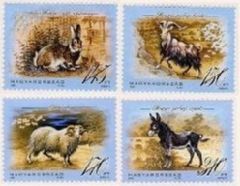Our living heritage Iv serie
Magyar Posta has a tradition of presenting some of Hungary’s indigenous domestic animals on postage stamps. Water buffalo have lived in this area for over a thousand years. Today water buffalo are kept for three uses: for their milk rich in fat and their meat, and as a draught animal. They are obedient and well-tempered with the keeper they are used to, and are usually shier than cattle. As they are a species of southern origin, in Hungary they have to be overwintered in a closed stable. With the de-crease in use of draught animals, their number fell significantly in Hungary, and today they are kept as a genetic reserve and pre-served as part of cultural history. The ancestors of the Hungarian giant rabbit were two species of Hungarian wild rabbit and the Belgian giant rabbit brought into Hungary. It is fed with hard fodder and large quantities of herbage. It is bred in four colour variations. The ears have blackish shading on the outer edges and on the tips. The fur is even coloured on all parts of the body. The mature rabbit weighs between 5.5–7 kg. It was accepted on the list of indigenous animals in 1994. Today there are only a few hundred of this species remaining. The Hungarian domestic goat is one of our legally protected indigenous domestic animals. It is not the result of conscious breeding. Presumably it was brought by the Magyar tribes when they settled in Hungary, and as a consequence of crossing with the goats of local peoples this solidly built adaptable species developed. Its colour varies between dun, grey, white, speckled and brownish grey, while in summer it is reddish with a dark stripe on its back. Twisted horns pointing upwards are typical of the billy goats. The history of cikta sheep in Hungary started after the Turkish occupation, when German-speaking people were settled in depopu-lated areas. They brought cikta sheep with them, which has a long, coarse, white fleece. In its original homeland, Germany, it has become extinct, which gives special importance to the stock in Hungary, as apart from a few isolated examples there is only one flock left of this breed. It has no economic use any more and is now kept primarily to preserve its genetic stock. The history of the Hungarian donkey goes back to the Beginning of the Common Era as the first donkeys were brought to the Car-pathian Basin by the Celts. They were never bred and they always reproduced naturally. Their colours are varied. Their most valu-able qualities are resistance to illness, hardiness, peaceful temperament, sturdiness, adaptable use, and undemanding care. They were recognised as a separate breed in 2004. On the frame and stamp design of the block there are water buffalos as part of a graphic composition recalling the environment typi-cal of them. As with the block, each animal of the stamps of the set appears with motifs referring to its habitat and environment. The stamps show in ascending order of face value the Hungarian giant rabbit, the Hungarian domestic goat, cikta sheep and the Hungar-ian donkey. The first day cover is illustrated by ornamental animal and floral decorations recalling pastoral art. The main motif of the commemorative postmark is the stylised drawing of the Hungarian domestic goat and cikta sheep.
| Type | special stamp |
| Short description | Magyar Posta has a tradition of presenting some of Hungary’s indigenous domestic animals on postage stamps. |
| Printing Office | Pénzjegynyomda |
| Issue year | 2008 |
| Issue time | 2010.04.15 11:46:37 |
| Perforation Sizer | 40 x 30 mm |
| Stamp Circulation | 400000 |
| Theme | animals,nature |
| Designer | Kálmán Székely |
| Stamped/Uncanceled | mint |


